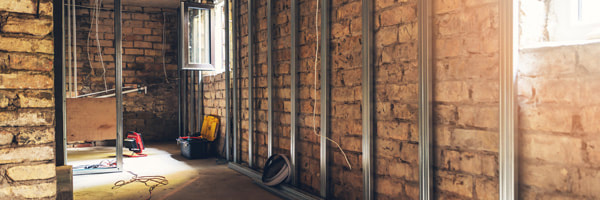|
Retrieved from: https://www.grangeinsurance.com/tips/does-home-insurance-cover-structural-damage If you’re not sure what kinds of structural repairs are covered by your home insurance policy, you aren’t alone. Home damage happens in many different forms and it’s not always obvious when your home has structural damage. The integrity of your home’s structure can slightly deteriorate over time or get ruined rapidly in a severe storm. Find out what structural damage is covered under most homeowners insurance policies. Plus, learn about additional insurance policies that can help you get the best protection for your home. What is structural damage to a building? You will notice structural damage immediately in many cases. Inside your home, things like ceiling damage, a cracked chimney or slanted floors are easy to spot. Licensed home inspectors primarily look at the four pillars which are the foundation, floor, walls and roof. Cracking, sagging, shifting or missing features on any of the pillars may be considered structural damage if the ruin is severe. Does home insurance cover structural problems?
The part of your home insurance policy that covers the home structure specifically is often referred to as dwelling protection. This sets it apart from other coverages within your homeowners policy such as personal property protection or liability protection. The source of your home damage plays a primary role in whether your home insurance policy will cover the costs for structural repairs. Two of the factors insurance companies usually consider are:
The Insurance Information Institute (III) says, “your homeowners policy pays to repair or rebuild your home if it is damaged or destroyed by fire, hurricane, hail, lightning or other disasters listed in your policy.” However, the following circumstances are not covered by home insurance:
In short, not all ruin from natural disasters is covered by a home insurance policy. Regular wear and tear are not considered covered losses. Luckily, there are different ways to supplement your home insurance to get extra protection for your needs.
5 structural repairs most home insurance will cover Homeowners insurance does cover some structural damage. Here are five home structural repairs or rebuilds you can expect your home insurance policy to cover:
Every insurance company offers different protection, so it’s important for you to know exactly what your policy says. If you have questions about home insurance policies, talk to us, your local independent agent to learn more. How to fix structural damage Find the right licensed contractor to complete structural repairs on your home. Roofing contractors can repair your roof and replace damaged or missing shingles. Construction contractors can repair cracked walls, fix slanted floors and mend issues in your home foundation. Choose home coverage that meets your needs You need a home insurance policy that offers great coverage with discounts and multiple ways to pay. Choose Grange Insurance to protect your home and property. You can expect great customizable dwelling, personal property, personal liability, equipment breakdown, identity theft coverage and more. Talk to a us today for more details. This article is for informational and suggestion purposes only. Implementing these suggestions does not guarantee coverage. If any policy coverage descriptions in this article conflict with the language in the policy, the language in the policy applies. For full details on Grange’s home insurance coverages and discounts, contact your local independent agent. References Home Inspection Insider Insurance Information Institute (III) Floodsmart.gov Insurance.ca.gov
0 Comments
by Justin Metz on January 17, 2022
Retrieved from: https://www.erieinsurance.com/blog/how-to-dig-out-of-snow If you live in an area that regularly sees snow, clearing the driveways and sidewalks after a winter storm is a regular part of life. But when severe winter weather strikes, and the snowfall is measured in feet instead of inches, digging out becomes a lot more work. Even if the weather caught you off guard, you’ll still have to brave the cold and dig your way out. Here are some tips to help you clear away all that ice and snow HOW TO CLEAR SNOW FROM YOUR SIDEWALKS If you own your own home, you are responsible for shoveling sidewalks on your property. In fact, homeowners can be held liable if someone is injured after falling on an obstructed walkway, so it’s important to ensure your sidewalk is cleared. Some places even have laws setting time frames by which snow must be cleared. Expectations vary by state, city and township, so review your local snow removal ordinances to avoid having to brave the cold and pay a fine or receive a citation on top of that. For clearing sidewalks, your options will be limited to a snowblower or shovel. If you’re shoveling, be sure to follow these snow shoveling safety tips to avoid an injury. When you’re finished, add salt or ice melt to the sidewalk to prevent ice buildup. HOW TO REMOVE SNOW FROM YOUR DRIVEWAY After a blizzard, you’ll want to quickly regain access to the street in front of your house. Here are a few options to get the job done: Snow plow While they do sell snow plow attachments for lawn tractors and ATVs, plowing typically isn’t a DIY job for most homeowners. However, hiring a snow plow may not be an option after a big snowstorm. Not only will demand be incredibly high after a blizzard, but really deep snow can become nearly impossible to plow. If you want to hire a snow plow, do it in advance of the storm. Unless a state of emergency has been declared, the plow company will probably come several times during the storm to keep the snow levels more manageable. Snow blower If you don’t have access to a plow, the easiest way to clear your driveway will be using a snow blower. When using a snow blower, start in the middle of your driveway and keep making U-turns to work outward. This allows you to blow snow to both sides of the drive. However, not all snow blowers are created equal. So before you get started, ensure your machine is up to the task.
Snow shovel Using a shovel is obviously the most labor-intensive method of clearing your driveway. However, if you shovel frequently during the snowstorm (instead of waiting until it’s over), you can lessen the amount of snow you need to move each time. You may spend more time shoveling, but it will be easier on your back. Experts also recommend using two types of shovels to clear your drive:
HOW TO DIG YOUR CAR OUT OF THE SNOW If the snow is so deep it’s hard to see your car, you’ve got some work ahead of you. First, clear the space around your vehicle so you’ve got room to work. Then, start from the top and work your way down. Avoid the temptation to use a snow shovel when clearing your car. You’ll risk leaving behind deep scratches in your vehicle’s paint or glass, which could require expensive repairs down the road. Instead, use a foam brush or non-abrasive snow broom to gently clear the snow away. Once you clear enough snow to get into your vehicle, you can start it up and let the defrosters melt any ice on the glass. Just be sure the area around the tailpipe is clear, too. WHAT IF MY CAR GETS STUCK IN THE SNOW? After you dig out your car, resist the urge to step on the gas and spin your wheels. That could put you in an even deeper rut by piling snow and ice around your tires. If you find yourself stuck, the best thing to do is steadily rock your vehicle from front to back. This helps your car gently build momentum to get up and out of the divots. Try carefully switching from drive to reverse. This helps you inch out of the rut by dislodging snow around your tires and creating a clear path to drive out. If that doesn’t work, try these tips:
HOW TO CLEAR SNOW AND ICE FROM YOUR ROOF AND GUTTERS After a blizzard, the extra weight of all that snow and ice could add up to more than your home can bear. Here’s what you need to know about clearing snow and ice from your roof.
HOW TO PREVENT OTHER PROBLEMS CAUSED BY HEAVY SNOW Your roof isn’t the only part of your home that can be damaged by deep snowfall. Be sure to check these other potential problem areas.
BE READY IN ANY WEATHER At Erie Insurance, we’re always here for you – no matter what mother nature throws your way. That’s why it pays to have a local ERIE agent on your side. Talk to us to learn more about auto insurance and home insurance from ERIE. |
Contact Us(740) 927-1469 Archives
August 2023
|
Navigation |
Connect With Us |
Contact Us |
Location |

